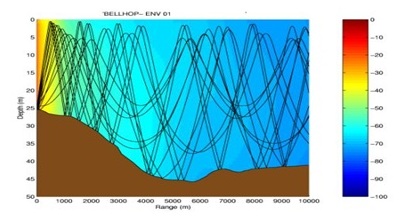Research Content 1: Research on the Transmission Characteristics of Underwater Acoustic Channels
To study the transmission characteristics, we are interested in the effects of multipath and fluctuation on the acoustic propagation under different frequencies by theoretical modeling and field observations. In addition, the characteristic parameters of the underwater acoustic channel will be extracted, the environmental sensitivity, the adaptive equalization method of the shallow water acoustic channels, and the Doppler shift and statistical characteristics under different sea conditions .

Research Content 2: Research on Underwater Acoustic Channels and Network Coded Cooperative Communications
In the cross-layer underwater acoustic networks, the double-layer rate compatible LDPC codes will be used to study the channel-network joint coding technology.Theinformation delivery characteristicsof the physical and network layerscouldimprove the system performancesduring itsiterative decoding; In the underwater acoustic communication models, the dynamic coding cooperation was proposed to achieveboth the diversity and coding gains. What’s more, the optimal analysis scheme of transmission delay and energy consumption in multi-hop acoustic communication networkswill be studied. In the underwater acoustic data collection networks, based onthe fact that the nodes can be overheardby others, we proposed dynamic codedcooperation for the underwater nodes.
Research Content 3: Research on Adaptive Coding for Underwater Acoustic Channels
In order to improve the reliability of data transmission, we will study the adaptive coding technology, and use the channel coding and equalization technology with good error correction capability and low coding complexity for the underwater acoustic channels, includingconvolutional codes, Turbo codes and regular / irregular LDPC codes, and rate compatible LDPC codes.
Research Content 4: Research on Underwater Noise Fields of anthropogenic and its Impact on Marine Life
We will study the distribution of underwater noise field of anthropogenic and its influence on marine life. The anthropogenic noises include: offshore wind farms, sea bridges, subsea tunnels, etc. during construction and operation periods. We will do on-site monitoring and data analysis of the underwater noises of offshore wind farms under construction in China, and then analyze and evaluate of underwater noise source level and time-frequency distributions under different marine engineering. In the mean while, we will study the acoustic propagation characteristics of marine mammals (Chinese white dolphins, Seal), including the time- frequency, source Level and propagation characteristics of its Whistle, Click and Burst Pulse acoustic signals.
Research Content 5: Research on underwater acoustic channel estimation
Aiming at the requirements of efficient modeling and estimation of underwater sound fields and acoustic channels, we will study the theory and key technologies of sound fields and acoustic channels. And also, we are interested in the efficient and robust estimation for underwater acoustic channels with multipath sparse distribution and strong time-varying under different marine environments. The research results can be widely used in high performance underwater acoustic communication system research and designs, which can overcome the performance degradation caused by the time-varying, multipath interference, and improve the detected SNR of the signal. Furthermore, it can provide technical supports for the underwater acoustic communication system research and designs, which be adapted to different marine environments, long distance, high speed, high Reliability.


